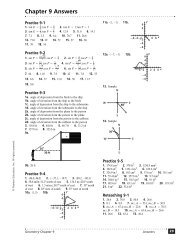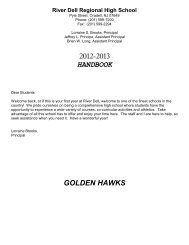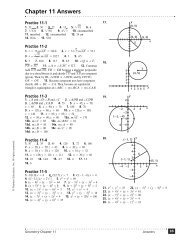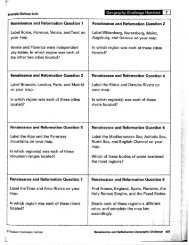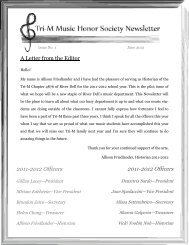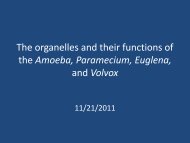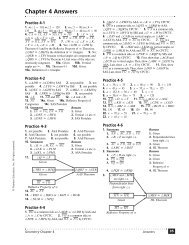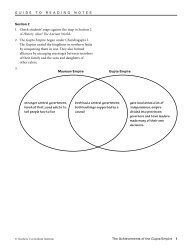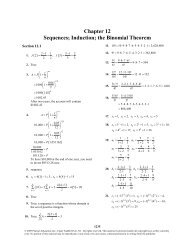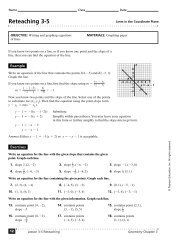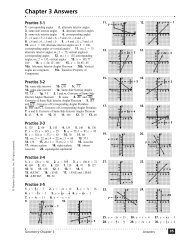Chapter 12 Answers (continued)
Chapter 12 Answers (continued)
Chapter 12 Answers (continued)
You also want an ePaper? Increase the reach of your titles
YUMPU automatically turns print PDFs into web optimized ePapers that Google loves.
<strong>Chapter</strong> <strong>12</strong> <strong>Answers</strong> (<strong>continued</strong>)<br />
each face in the image has two times the perimeter and four<br />
times the area of the corresponding face in the preimage.<br />
7. Surface area of image = 96 sq. units; surface area of<br />
preimage = 24 sq. units; the ratio of the surface areas is<br />
4 : 1. 8. Volume of image = 64 cubic units; volume of<br />
preimage = 8 cubic units; the ratio of the volumes is 8 : 1.<br />
9. Dilations in three dimensions are proportional to dilations<br />
in two dimensions.<br />
<strong>Chapter</strong> Project<br />
Activity 1: Investigating<br />
a. vertical<br />
b. vertical<br />
c. both<br />
Activity 2: Modeling<br />
a. Ancient Egyptian ornament<br />
✔ Checkpoint Quiz 2<br />
1. line symmetry;<br />
rotational; 180°<br />
2. line symmetry;<br />
rotational; 180°<br />
3. line symmetry<br />
H<br />
b. Oriental design<br />
c. Greek vase design<br />
Activity 3: Investigating<br />
a, b<br />
Activity 4: Classifying<br />
a. mg<br />
b. <strong>12</strong><br />
Activity 5: Creating<br />
Check students’ work.<br />
✔ Checkpoint Quiz 1<br />
1. No; the figures are not the same size. 2. yes<br />
3. yes 4. –3, –2 5. 6 units right and 4 units down<br />
6. a resultant translation of 4 units right and 11 units up<br />
7. C<br />
8. D'<br />
L<br />
C'<br />
B'<br />
L' A B'<br />
B D<br />
B<br />
C<br />
C'<br />
A, A'<br />
9.<br />
C<br />
C'<br />
A<br />
D D'<br />
10. T( 8, -5), Q(2, -3) and R(4, 0)<br />
4. rotational; 180° 5. translational; no turns<br />
6. rotational; preimage turns 7. translational<br />
8. rotational, reflectional, translational 9. translational<br />
<strong>Chapter</strong> Test, Form A<br />
1. P(13, 0), Q(10, -2), R(11, -4), S(13, -6)<br />
2. P(-1, -2), Q(2, -4), R(1, -6), S(-1, -8)<br />
3. P(0, -5), Q(2, -2), R(4, -3), S(6, -5)<br />
4. P(-2.5, 0), Q(-1, -1), R(-1.5, -2), S(-2.5, -3)<br />
5. P(5, 2), Q(2, 0), R(3, -2), S(5, -4) 6. P(-11, 3),<br />
Q(-8, 1), R(-9, -1), S(-11, -3) 7. glide reflection<br />
8. translation 9. translation 10. rotation<br />
11.<br />
<strong>12</strong>. line symmetry 13. rotational symmetry<br />
14a. Any two of the following: ABCDEHIKMOTUVWXY<br />
14b. Any two of the following: HINOSXZ<br />
15. Translations can be performed on the pieces because they<br />
can slide. Rotations can be performed on the pieces because<br />
each piece can be turned. Reflections and glide reflections<br />
cannot be performed on the pieces because the back of a<br />
puzzle piece is useless in solving the puzzle. Dilations are<br />
impossible because the pieces cannot change size.<br />
16. A 17. Sample: glide reflectional, rotational, line,<br />
and translational<br />
1 3<br />
18. L(-3, 6), M(6, 6), N(3, -9) 19. L( 2 , - 4 ),<br />
3 5 1<br />
M( 4 ,1), N( 4, - 2) 20. L(-18, -18), M(-18, 18),<br />
5 7<br />
N(0, 0) 21. L(3, -2), M(0, - 3 ), N( 3, -2)<br />
© Pearson Education, Inc. All rights reserved.<br />
42<br />
<strong>Answers</strong> Geometry <strong>Chapter</strong> <strong>12</strong>




